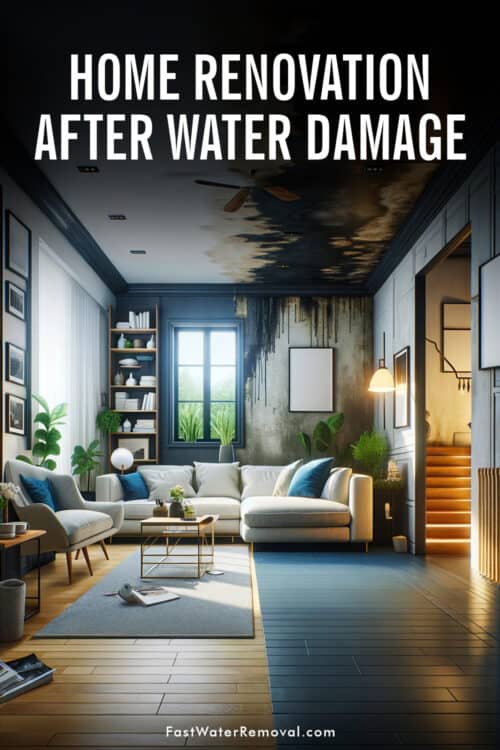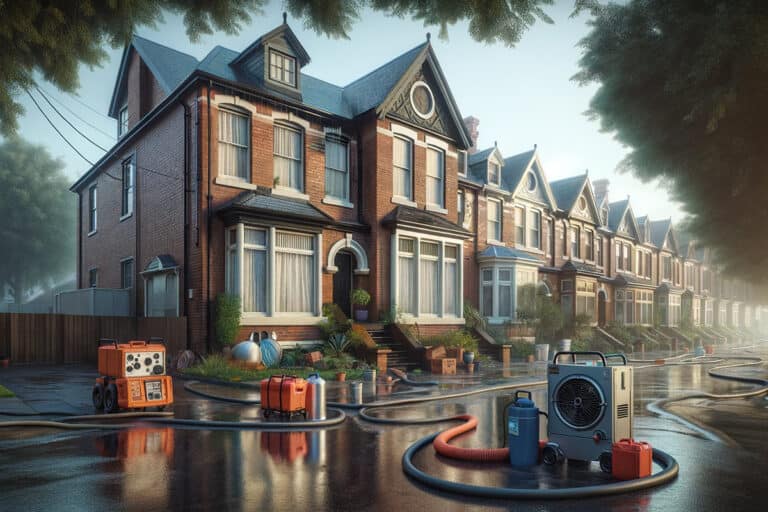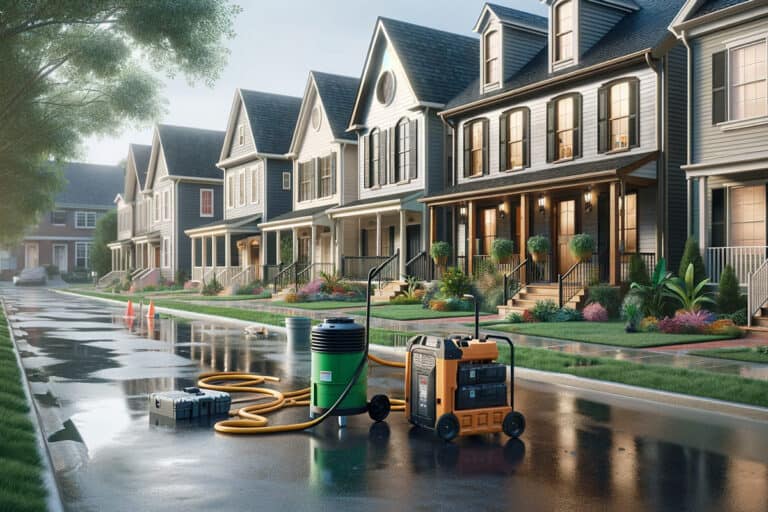Disclosure: I am compensated for purchases made through some links on this site. Click for details.
In the aftermath of water damage, homeowners often face a storm of concerns and challenges. Yet, within this upheaval lies a silver lining—a unique opportunity not just to restore but to transform your home into something even more valuable and resilient. This guide delves into the essential steps for a successful renovation after water damage, focusing on strategic planning, the selection of durable materials, and the integration of energy-efficient innovations. Our aim is to navigate you through this challenging time, turning adversity into advantage, and ensuring your renovated home emerges stronger, more beautiful, and more sustainable than ever before.
Water damage, while daunting, doesn’t have to spell disaster. With the right approach, it can serve as a catalyst for remarkable home improvements, offering a chance to rethink, redesign, and rejuvenate your living spaces. From assessing the extent of damage to choosing water-resistant materials and modernizing your home’s energy efficiency, this article provides a roadmap for turning water-induced woes into wins.
Let’s start transforming the challenge of water damage into an opportunity for home enhancement that aligns with your vision of the perfect living space.
Assessing the Damage and Planning Your Renovation
Before any nails are hammered or tiles laid, the first crucial step in your home’s transformation journey is a thorough assessment of the damage. This stage is pivotal, as it lays the foundation for a successful renovation, ensuring safety, functionality, and aesthetic improvements align with your long-term goals.
When to Seek Professional Help
Navigating the aftermath of water damage requires a keen eye and expertise to identify issues that may not be immediately apparent. Here are instances when calling in professionals is imperative:
- Structural Concerns: Water can compromise the integrity of your home’s structure. Professionals can assess the extent of the damage and recommend necessary repairs to ensure your home remains safe and secure.
- Electrical and Plumbing Systems: Water and electricity make for a hazardous mix. A certified electrician should inspect your electrical system. Similarly, plumbing issues require attention from a qualified plumber to prevent future leaks and water damage.
- Mold Inspection: Given the health risks associated with mold, a professional mold assessment is crucial, especially in hidden areas like behind walls or under floors.
Tips for Finding Reliable Contractors:
- Seek Referrals: Recommendations from friends, family, or neighbors who have undergone similar renovations can be invaluable.
- Read Reviews: Online platforms offer insights into a contractor’s reliability, quality of work, and customer service.
- Verify Credentials: Ensure the professionals you hire are licensed, insured, and have a solid track record.
Setting Your Renovation Priorities
With a professional assessment in hand, you can prioritize your renovation projects based on urgency, budget, and desired outcomes. Consider the following steps:
- Address Immediate Safety Hazards: Prioritize repairs that ensure the structural integrity and safety of your home.
- Plan for Moisture Control: Implement solutions to prevent future water damage, such as improving drainage or waterproofing basements.
- Restore Essential Areas: Focus on getting key areas like kitchens and bathrooms back in operation to make your home livable.
- Consider Aesthetic and Functional Upgrades: Once the essentials are addressed, think about enhancements that align with your vision for the space.
Creating a Comprehensive Renovation Plan:
- Outline Your Goals: Clearly define what you want to achieve with your renovation, considering both needs and desires.
- Budget Accordingly: Establish a realistic budget that includes a contingency fund for unexpected costs.
- Timeline: Develop a timeline for your renovation, understanding that some projects may need to be phased.
By carefully assessing the damage and thoughtfully planning your renovation, you set the stage for a successful transformation of your home. This process not only ensures a safer, more functional living space but also opens the door to infusing your home with personal touches and modern upgrades that enhance your quality of life.
Choosing the Right Materials for Water Damage Resilience
Once the foundation for renovation is laid out through thorough assessment and planning, the next step is selecting materials that will not only repair the damage but also prevent future issues. Opting for water-resistant and durable materials is essential in areas prone to moisture, ensuring your home stands resilient against potential water damage.
Water-Resistant Flooring Options
Flooring is often the hardest hit in cases of water damage, making the choice of material crucial for resilience and longevity.
- Tile and Porcelain: Ideal for bathrooms and kitchens, these materials offer water resistance and ease of cleaning.
- Luxury Vinyl Plank (LVP): Mimics the look of wood without the susceptibility to water damage, perfect for living areas and basements.
- Concrete: Polished concrete floors are an excellent option for modern homes, providing durability and resistance to moisture.
Related Content:
- Water Damage Wood: Prevention and Repair Strategies
- Carpet Restoration After Water Damage
- Silk and Oriental Rug Water Damage Restoration Guide
Moisture-Proof Wall Solutions
Protecting your walls from moisture is just as critical as flooring to prevent mold growth and structural damage.
- Moisture-Resistant Drywall: Specially designed for high-humidity areas like bathrooms and kitchens, it’s an essential upgrade from standard drywall.
- Water-Resistant Paint: Available in various finishes, these paints add an extra layer of moisture protection while refreshing your home’s aesthetics.
Durable Countertops and Cabinetry
Kitchens and bathrooms benefit significantly from materials that can withstand water exposure.
- Quartz Countertops: Non-porous and resistant to staining, quartz is an ideal choice for areas susceptible to water spills.
- Plywood Cabinetry: Compared to particleboard, plywood offers better resistance to moisture, ensuring the longevity of your cabinetry.
Selecting Fixtures and Hardware
Opt for fixtures and hardware designed to resist corrosion and wear in damp environments.
- Stainless Steel and Brass Fixtures: These materials can withstand moisture without rusting or tarnishing, ideal for kitchen and bathroom fixtures.
- Silicone Caulking: A superior alternative to traditional caulking for sealing gaps around showers, bathtubs, and sinks, providing a durable, watertight seal.
Incorporating Smart Technology
Smart home technologies can play a pivotal role in preventing water damage, offering early detection and automation to mitigate risks.
- Water Leak Detectors: Install smart sensors in critical areas to alert you of leaks before they cause significant damage.
- Automated Shut-Off Valves: These systems can automatically cut off the water supply in case of a detected leak, preventing extensive water damage.
By choosing materials and technologies that enhance the resilience of your home against water damage, you not only restore your property but also invest in its future safety and sustainability. These selections contribute to a renovation that not only repairs but significantly upgrades the quality and durability of your living space.
Energy Efficiency and Modernization
Renovating your home after water damage is not just about restoration; it’s an opportunity to upgrade your home’s energy efficiency and integrate modern features that align with today’s standards for comfort, convenience, and sustainability. Incorporating energy-efficient solutions can significantly reduce your carbon footprint and energy bills over time.
Upgrading to Energy-Efficient Appliances
Appliances account for a substantial portion of household energy consumption. Opting for energy-efficient models can offer considerable savings:
- ENERGY STAR Appliances: Look for appliances with the ENERGY STAR label, indicating they meet or exceed energy efficiency guidelines set by the U.S. Environmental Protection Agency.
- High-Efficiency HVAC Systems: Modern heating, ventilation, and air conditioning systems are designed to use less energy while providing better temperature and humidity control.
Enhancing Insulation and Sealing
Improving your home’s insulation and sealing leaks are among the most cost-effective ways to increase energy efficiency:
- Insulation Upgrades: Enhance insulation in walls, attics, and basements to maintain your home’s internal temperature, reducing the need for heating and cooling.
- Weatherproofing: Seal doors and windows to prevent air leaks. Consider double or triple-glazed windows for additional insulation.
Smart Home Technologies for Energy Management
Smart home devices not only offer convenience but also help in managing and reducing energy usage:
- Smart Thermostats: These devices learn your heating and cooling preferences, adjusting automatically to save energy while keeping you comfortable.
- LED Lighting: Replace traditional bulbs with LED lights, which consume a fraction of the energy and last much longer.
- Solar Panels: If feasible, solar panels can provide a renewable energy source, significantly reducing electricity bills and increasing your home’s value.
Related Content: Harnessing Smart Home Technology for Water Damage Prevention
Considerations for Water Heating
Water heating is a significant energy expense. Consider these energy-efficient options:
- Tankless Water Heaters: These only heat water on demand, which can lead to energy savings compared to traditional tank heaters.
- Solar Water Heaters: Utilize solar energy to heat your home’s water, offering an eco-friendly and cost-effective solution.
Sustainable Material Choices
Selecting sustainable materials for your renovation not only supports environmental conservation but can also contribute to a healthier home environment:
- Recycled Materials: Opt for recycled or sustainably sourced materials for flooring, countertops, and cabinetry.
- Low-VOC Products: Choose paints and finishes with low volatile organic compounds (VOCs) to improve indoor air quality.
Renovating with energy efficiency and modernization in mind positions your home for the future, making it more comfortable, sustainable, and adaptable to evolving energy standards. This approach not only aids in the recovery from water damage but also enhances the long-term livability and value of your property.
Professional Help and Resources
Tackling a renovation project after water damage involves numerous decisions and tasks that can benefit greatly from professional expertise and guidance. While some aspects of the renovation can be managed as DIY projects, others require the skills and knowledge of professionals to ensure the work is done safely and up to code.
Identifying When You Need Professional Help
Certain renovation tasks demand a professional touch for optimal results and to avoid potential hazards:
- Structural Repairs: If water damage has affected the structural integrity of your home, a structural engineer or qualified contractor should assess and address these issues.
- Electrical and Plumbing Updates: To ensure safety and compliance with local building codes, electrical and plumbing work often requires licensed professionals.
- Mold Remediation: Professional mold removal is crucial to prevent health risks and ensure the mold is thoroughly eradicated.
Finding and Choosing the Right Professionals
Selecting the right professionals is critical for the success of your renovation project. Here are steps to ensure you find the best fit:
- Gather Referrals: Start by asking friends, family, or neighbors for recommendations of professionals they have had a good experience with.
- Check Reviews and Ratings: Online platforms can provide valuable insights into a professional’s work quality and reliability through customer reviews and ratings.
- Verify Licenses and Insurance: Ensure any professionals you consider hiring are licensed to work in your area and carry insurance to protect against potential damages or injuries.
- Request Multiple Quotes: Obtaining quotes from several contractors can give you a clearer picture of the project’s cost and help you make an informed decision.
Utilizing Online Resources
The internet offers a wealth of resources that can assist you in planning and executing your renovation project:
- Educational Platforms: Websites and YouTube channels dedicated to home improvement offer tutorials and advice on a wide range of renovation topics.
- Design Inspiration: Platforms like Pinterest and Houzz can provide inspiration for your renovation projects, from color schemes to layout ideas.
- Project Management Tools: Online tools can help you plan, track, and manage your renovation project, keeping you organized and on budget.
Leveraging Community Knowledge
Don’t underestimate the value of local knowledge and experience:
- Local Building Codes: Familiarize yourself with local building codes and regulations to ensure your renovation complies with all requirements.
- Community Forums: Local online forums and social media groups can be excellent sources for finding recommendations for professionals and advice on managing renovation challenges specific to your area.
Engaging the right professionals and making use of available resources can significantly enhance the renovation process, ensuring your project is completed efficiently, safely, and to your satisfaction. By carefully selecting experts and leveraging online and community resources, you can navigate the complexities of renovating after water damage with confidence and achieve the desired outcome for your home.
Conclusion
Navigating the aftermath of water damage in your home can be a daunting and stressful journey. However, with careful planning, strategic decision-making, and the right support, it can also become an opportunity to not only restore your home but to enhance its functionality, aesthetics, and resilience against future incidents. This guide aims to provide a comprehensive roadmap to help you transform the challenge of water damage into a chance for substantial home improvement.
Key Takeaways
- Professional Assessment is Crucial: Begin with a thorough evaluation of the damage by professionals to ensure the safety and integrity of your renovation project.
- Prioritize Wisely: Focus on immediate safety concerns and moisture control before moving on to aesthetic improvements and upgrades.
- Choose Durable, Water-Resistant Materials: Investing in quality materials can prevent future damage and save money in the long run.
- Energy Efficiency Adds Value: Modernizing your home with energy-efficient solutions not only helps the environment but also reduces utility bills and increases property value.
- Seek Professional Help When Needed: Certain aspects of the renovation require the expertise of professionals to ensure the work is done safely and correctly.
- Utilize Available Resources: Leverage online tools, platforms, and community insights to guide your decisions and inspire your renovation plans.
Moving Forward
As you embark on your renovation journey, remember that turning your vision into reality will require patience, flexibility, and persistence. Each decision you make—from the selection of materials to the choice of contractors—contributes to the overall success of your project. While the path may seem long and sometimes complex, the reward of a beautifully renovated home, tailored to your needs and preferences, is well worth the effort.
Your Next Steps
- Review and Finalize Your Renovation Plan: Ensure your plan is comprehensive, covering all necessary repairs, upgrades, and aesthetic enhancements.
- Set a Realistic Budget: Include a contingency fund for unforeseen expenses to avoid financial strain during the renovation process.
- Schedule Your Projects: Organize your renovation tasks in a logical sequence, starting with structural repairs and moisture prevention.
- Stay Informed and Involved: Keep yourself informed about the progress of the renovation and maintain open communication with your contractors and professionals.
Renovating after water damage offers a unique opportunity to not just repair but reimagine and reinvent your living space. With the right approach, your renovated home can emerge more beautiful, functional, and resilient than ever before, turning a moment of adversity into a lasting investment in your comfort and happiness.







